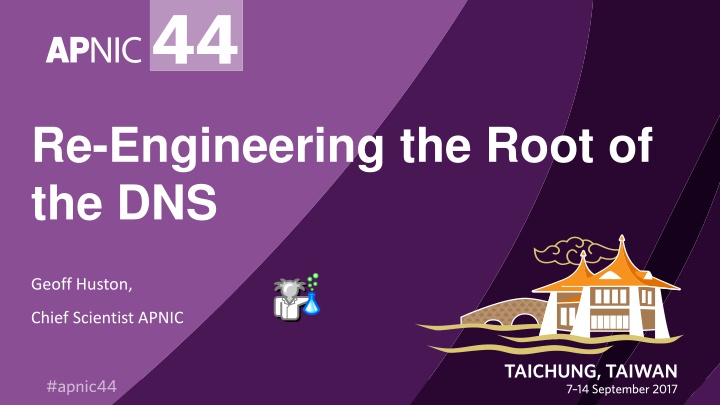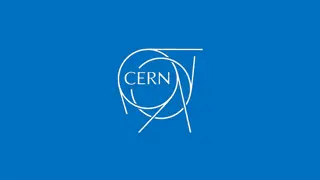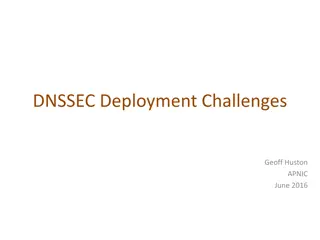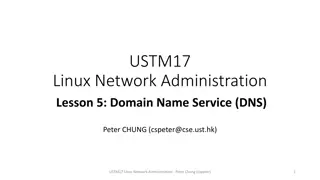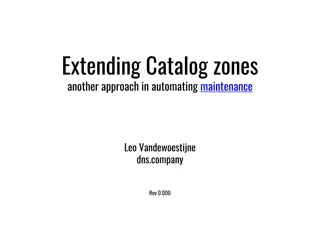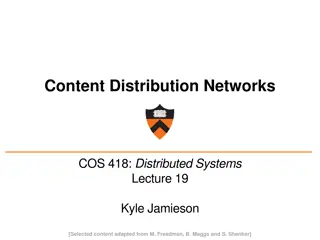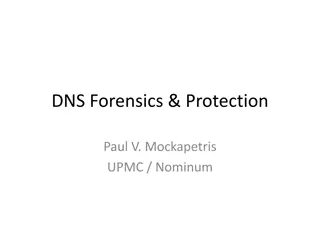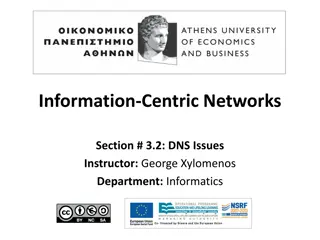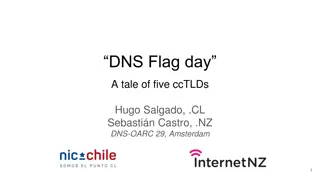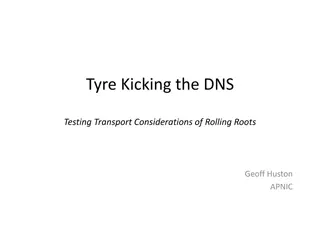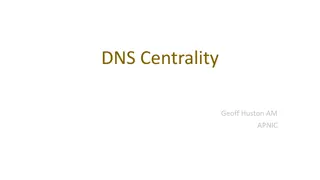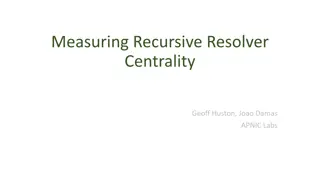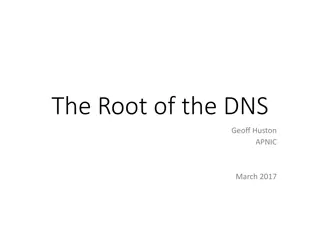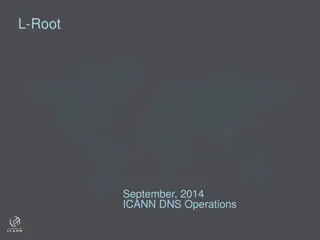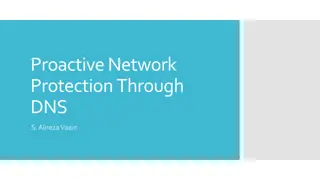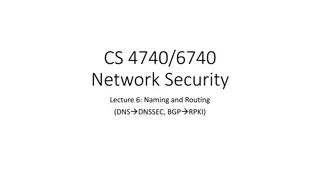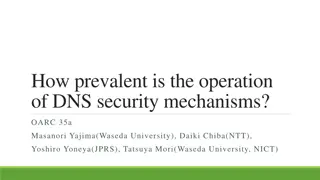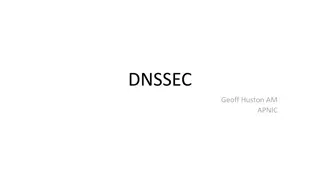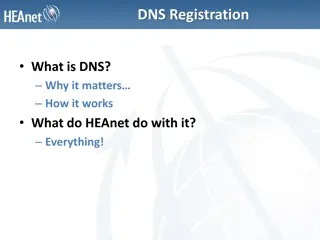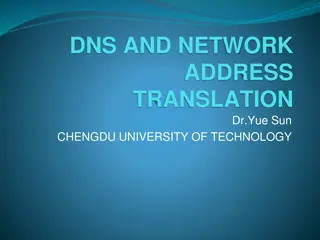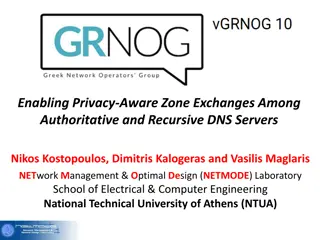Re-Engineering the Root of the DNS by Geoff Huston
The presentation discusses the DNS and the root server infrastructure, along with recent initiatives by APNIC to enhance the system. It covers the structure of the Domain Name System, the role of DNS name servers, and the process of resolving DNS names.
Download Presentation

Please find below an Image/Link to download the presentation.
The content on the website is provided AS IS for your information and personal use only. It may not be sold, licensed, or shared on other websites without obtaining consent from the author.If you encounter any issues during the download, it is possible that the publisher has removed the file from their server.
You are allowed to download the files provided on this website for personal or commercial use, subject to the condition that they are used lawfully. All files are the property of their respective owners.
The content on the website is provided AS IS for your information and personal use only. It may not be sold, licensed, or shared on other websites without obtaining consent from the author.
E N D
Presentation Transcript
Re-Engineering the Root of the DNS Geoff Huston, Chief Scientist APNIC
In this presentation I ll talk about the DNS, and the root server infrastructure in particular And some recent initiative by APNIC to try and improve the situation 2
The Structure of the Domain NameSystem The Domain Name System (DNS) is a distributed data collection using a delegation hierarchy that reflects the internal hierarchical structure of domain names. At each level in the name hierarchy each label represents a potential point of administrative delegation . ( root ) zone com. zone www.example.com. example.com. zone www.example.com.
The Structure of the Domain NameSystem The Domain Name System (DNS) is a distributed data collection using a delegation hierarchy that reflects the internal hierarchical structure of domain names. At each level in the name hierarchy each label represents a potential point of administrative delegation . ( root ) zone Delegation of the label com com. zone Delegation of the label example www.example.com. example.com. zone terminal label www www.example.com.
DNS Name Servers Every DNS zone has a set of authoritative servers that can answer queries for names defined by that zone The Root Zone is just another zone in that respect, and the authoritative servers for that zone are called Root Servers There are 13 Root Server names And these names are used to label Anycast Name Server constellations Which means that there are probably some thousands of discrete Root Server instances if you could peek inside all of these these anycast clouds 5
Resolving a DNS Name Your resolver needs need to ask a DNS server for the zone that contains the terminal label for the associated information (resource record) associated with the DNS name But Where exactly is the zone cut? Who are the servers? So resolvers discover this information by performing a top-down iterative search
Resolving a DNS Name Qname: www.example.com.? . ( root ) zone server Response: servers for the com. zone
Resolving a DNS Name Qname: www.example.com.? . ( root ) zone server Response: servers for the com. zone Qname: www.example.com.? com. zone server Response: servers for the example.com. zone
Resolving a DNS Name Qname: www.example.com.? . ( root ) zone server Response: servers for the com. zone Qname: www.example.com.? com. zone server Response: servers for the example.com. zone example.com. zone server terminal label Qname: www.example.com.? Response: Resource records for terminal label www.example.com.
Resolving a DNS Name Every DNS resolution procedure starts with a query to the root! Qname: www.example.com.? . ( root ) zone server Response: servers for the com. zone Qname: www.example.com.? com. zone server Response: servers for the example.com. zone example.com. zone server terminal label Qname: www.example.com.? Response: Resource records for terminal label www.example.com.
How to be bad Every DNS resolution procedure starts with a query to the root! If an attacker could prevent the root servers from answering DNS queries then the entire Internet will suffer! 11
Caching in the DNS The main role of the root server system is to answer queries that are not cached in local name caches The vast majority of the queries that are passed to the root zone servers (some 2/3 of root queries) generate a no-such- name (NXDOMAIN) response from the root system
How to be bad To attack the root servers you need to get past DNS resolver caches. This means you need to have every query in the DNS attack flow ask for a different non-existent name 13
Root Servers are a highly visible attack target 14
Root Servers are a highly visible attack target 15
Root Servers are a highly visible attack target If you can prevent resolvers from getting answers from the root then the resolvers will stop answering queries as their local cache expires 16
Root Servers are a highly visible attack target If you can prevent resolvers from asking the root then the resolvers will stop answering queries as their cached responses expire 17
Root Servers are a highly visible attack target If you can prevent resolvers from asking the root then the resolvers will stop answering queries as their cached responses expire 18
How should we defend the Root? Larger Root Server platforms? More Root Server Letters? More Anycast Instances? Change Root Server response behaviours? Or 19
How should we defend the Root? Larger Root Server platforms? More Root Server Letters? More Anycast Instances? Change Root Server response behaviours? Or * Distributed parallel attacks can scale up in intensity more effectively than a single point of service can scale its defence mechanisms 20
How should we defend the Root? Larger Root Server platforms? More Root Server Letters? More Anycast Instances? Change Root Server response behaviours? Or * The limit of 13 distinct root server names is an inherited limit that these days has a political dimension that has largely supersedes the original technical reasons for the limit. In any case more letters is not a very good DDOS defence! 21
How should we defend the Root? Larger Root Server platforms? More Root Server Letters? More Anycast Instances? Change Root Server response behaviours? Or 22
Anycast Root Servers 12 of the 13 root server letters operate some form of anycast server constellation. All the servers in a constellation respond to the same public IP addresses. The routing system will direct resolvers to pass their query to a particular root letter to the closest member of the letter s anycast constellation. Anycast provides: faster responses to queries to the root for many DNS resolvers Greater resilience to hostile traffic by load sharing widely distributed attacks across the entire anycast constellation, and absorbing a single point attack on a single server instance
Anycast Root Servers 12 of the 13 root server letters operate some form of anycast server constellation. All the servers in a constellation respond to the same public IP addresses. The routing system will direct resolvers to pass their query to a particular root letter to the closest member of the letter s anycast constellation. Anycast provides: faster responses to queries to the root for many DNS resolvers Greater resilience to hostile traffic by load sharing widely distributed attacks across the entire anycast constellation, and absorbing a single point attack on a single server instance
How do we defend the Root today? As the traffic levels to the root servers increases both as steady state query levels and instances of attacks, we keep on adding more instances to the existing anycast clouds
The attackers are our own recursive resolvers! We are scaling the DNS root server infrastructure in order to be resilient against floods of queries about non- existent names coming from the existing DNS resolvers, who are scaling their own capabilities to survive the very same query attacks that are being directed against them! 28
How do we defend the Root today? As the traffic levels to the root servers increases both as steady state query levels and instances of attacks, we keep on adding more instances to the existing anycast clouds What we are in effect doing is building ever bigger and larger trash processors to handle ever larger amounts of garbage queries to cope with these ever larger attacks
Can we jump out of this vicious cycle? Can we change the behaviour of the DNS system to improve both its service and its resilience?
DNSSEC changes Everything Before DNSSEC we relied on the assumption that if we asked an IP address of a root server, then the response was genuine With DNSSEC we can ask anyone, and then use DNSSEC validation to assure ourselves that the answer is genuine How can we use this?
DNSSEC-Enabled Directions for the Root Service If we could answer NXDOMAIN queries from recursive resolvers we could reduce the load on the root servers by close to 70% This would be a very significant win: reducing root query traffic providing faster response to these queries reduces the local cache load on recursive resolvers
Local Root Secondaries RFC 7706 Enlist DNS resolvers to offer a root zone secondary service If resolvers use this approach then they only need to query a root server infrequently and perform a zone transfer of the current state of the root zone (IXFR from a root server), and use this validated copy of the root zone to directly answer all queries that refer to the root zone
NSEC caching RFC 8198 Most of the queries seen at the root are for non-existent domains, and resolvers cache the non-existence of a given name But a DNSSEC-signed NXDOMAIN response from the root zone actually describes a range of labels that do not exist, and it s the range that is signed, not the actual query name If resolvers cached this range and the signed response, then they could use the same signed response to locally answer a query for any name that falls within the same label range This has a similar effect to RFC7706, but without any configuration overhead, nor is there any requirement for supporting root zone transfers.
NSEC caching For example, if you were to query the root server for the non-existant name www.example. the returned response from the root says that there are NO TLDS between everbank. and exchange. The same response can be used to respond to queries for every TLD between these labels. So we can cache this range response and use it to respond to subsequent queries that fall into the same range 35
Architecturally speaking Rather than have recursive resolvers act as amplifiers for DNS queries for non-existent names, NSEC caching enlists these recursive resolvers to act on behalf of the root servers, and provide the answers for them. This approach uses existing DNS functionality and existing queries there is nothing new in this. The change here is to take advantage of the use of the NSEC response to define a range of names, allowing what is in effect semi-wildcard cache entries that can be used to respond to a range of query labels 36
Impacts Rather than trying to expand the capabilities of the root zone servers, we can leverage the massive number of already deployed recursive resolvers to extend their cache to cover both defined and non-existant root labels We anticipate that this will have a major effect on the DNS by absorbing most of the current root query load at the edge, rather than passing these queries into the root system 37
Impacts NSEC caching can also help recursive resolvers Instead of caching non-existent individual names they can cache the NSEC-described range, and refresh the cached NSEC record instead of any individual name This will shrink the demands placed on the local cache, which can improve local cache performance in the recursive resolver 38
Coming to a Bind Resolver near you APNIC has sponsored the inclusion of this NSEC caching code for the root zone in the forthcoming Bind 9.12 release This function will be enabled by default in this release We hope that other DNS resolver vendors also implement this feature, as widespread use of NSEC caching will have a dramatic positive impact on the root server ecosystem!
